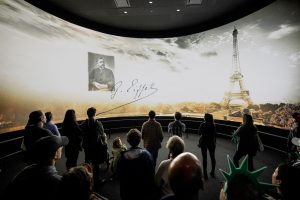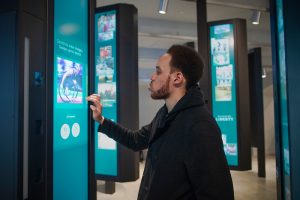For the 4.3 million people who visit The Statue of Liberty in New York harbor each year, experiencing the monument’s history firsthand is a major part of  the journey.
the journey.
With the May 2019 opening of The Statue of Liberty Museum, created by The Statue of Liberty-Ellis Island Foundation, Inc., each visitor can explore its history through immersive interactive exhibits powered by industry-leading RealMotion servers. The content, which leverages cutting-edge interactive video technologies, was designed by ESI Design, who enlisted Montréal-based experience design studio Float4 to produce and integrate the technology and programming behind the content.
“The 16 RealMotion servers we used for this project are crucial to creating the multi-sensory, multi-room interactive experience that FX Collaborative and ESI Design envisioned for the museum,” said RealMotion Director Geoff Platt. “The result is an exciting journey where guests learn about each stage of the statue’s life and history through interactive RealMotion experiences that bind emotive interactive content to various sensors within the technology infrastructure.”
The journey begins in the Immersive Theater, where three wall-sized curved projection screens take guests to new heights with aerial videos, historical footage and a flythrough of the statue’s interior generated and delivered by three RealMotion servers. A connected countdown screen helps regulate the flow of visitors through the Immersive Theater. All four displays are synchronized to cultivate a seamless visitor experience.
The Becoming Liberty experience is a salute to the diverse connotations of Lady Liberty and takes advantage of innovations in generative visuals driven by real-time data. Thousands of guests are invited to use any of the 20 touchscreen kiosks to share their country of origin as well as a personal photo taken at the kiosk, and to choose a selection of images that represent their idea of ‘liberty.’ All kiosks communicate with a content management system located in the RealMotion server. This CMS receives updatable content and submissions created from the kiosks. Cloud-based artificial intelligence software work with RealMotion’s servers to automatically consolidate more than 30,000 data points into a cyclically-updated digital mural, displayed on ‘The Canvas’, a 40-foot-wide by 11-foot-tall digital screen.
 In the exhibits for Imagining Liberty and Embracing Liberty there are additional interactive moments in the forms of ‘Bartholdi’s Sketches’ and ‘The Statue in Popular Culture’. Four touchscreen stations engage guests with dynamic applications that feed data in real time to four connected RealMotion servers. In this instance, the servers’ most important function is to provide ultimate reliability for constant operation, eliminating the need for frequent maintenance or intervention.
In the exhibits for Imagining Liberty and Embracing Liberty there are additional interactive moments in the forms of ‘Bartholdi’s Sketches’ and ‘The Statue in Popular Culture’. Four touchscreen stations engage guests with dynamic applications that feed data in real time to four connected RealMotion servers. In this instance, the servers’ most important function is to provide ultimate reliability for constant operation, eliminating the need for frequent maintenance or intervention.
“In each exhibit, the RealMotion platform is vital to consistent operation and successful guest engagement,” said Platt. “As an island-based attraction with minimal on-site support staff, the superior level of reliability RealMotion offers is necessary. Reliability in servers is a necessary trait, so that developers, creatives and owners can build successful, long-term interactive experiences. All the installations in the museum have a redundant back-up server, so if an issue ever does arise, all the content, structures and particles are automatically transferred to the backup to ensure that there are no interruptions to daily operation.”
 The Statue of Liberty Museum was designed by architecture firm FX Collaborative, and constructed by Phelps Construction Group. The interactive exhibits, designed by ESI Design and integrated by Float4, demonstrate the capabilities of real-time graphics in a culture-consumption setting. RealMotion is proud to power the captivating installations of the Statue of Liberty Museum.
The Statue of Liberty Museum was designed by architecture firm FX Collaborative, and constructed by Phelps Construction Group. The interactive exhibits, designed by ESI Design and integrated by Float4, demonstrate the capabilities of real-time graphics in a culture-consumption setting. RealMotion is proud to power the captivating installations of the Statue of Liberty Museum.










